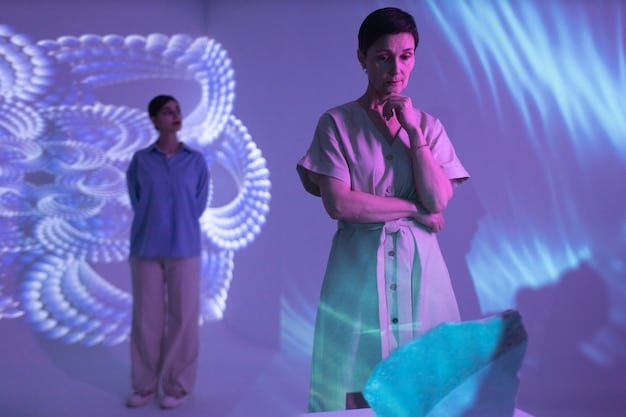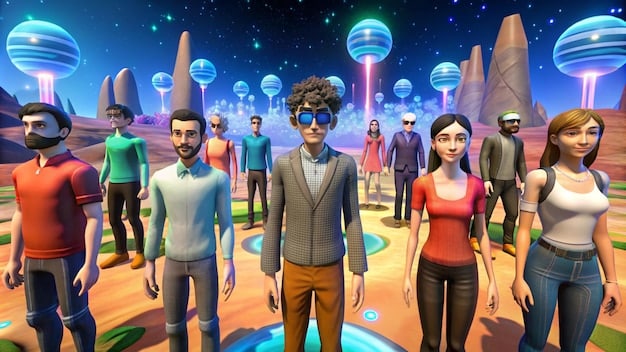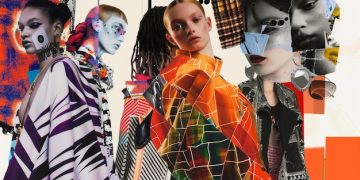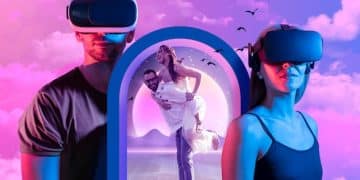Metaverse Mastery: Opportunities for Emerging Artists in Virtual Concerts

The metaverse is evolving into a pivotal stage for emerging artists, offering unprecedented opportunities to engage global audiences and redefine live music through immersive virtual concerts, fostering new revenue streams and creative expression.
The digital frontier continues to expand, and with it, the landscape for artistic expression morphs in fascinating ways. For emerging artists, understanding and leveraging these shifts can be the key to unlocking new audiences and revenue streams. One such transformative shift is found in mastering the metaverse: opportunities for emerging artists in virtual concerts, a realm where the boundaries of physical and digital performance blur, opening up a universe of possibilities previously unimaginable.
The rise of virtual concert platforms
The concept of virtual concerts has rapidly moved from niche interest to mainstream phenomenon, particularly accelerated by global events that restricted in-person gatherings. These digital stages are more than mere video streams; they are immersive experiences designed to replicate, and in some cases, surpass the engagement of traditional live shows.
Platforms like Roblox, Fortnite, and Decentraland have pioneered this movement, hosting massive concerts featuring headlining acts. For emerging artists, this presents a unique chance to occupy virtual real estate and connect with audiences globally without the logistical complexities and prohibitive costs associated with physical touring.
Beyond the screen: immersive experiences
Virtual concerts in the metaverse are characterized by their interactive and communal nature. Attendees often exist as avatars, capable of moving, socializing, and participating in the show in ways that transcend passive viewing. This introduces a dynamic element that can foster deeper connections between artists and their fan base.
- Avatar Customization: Fans can express individuality and align with artist branding.
- Interactive Environments: Stages that react to music, audience interactions, and even artist gestures.
- Virtual Merchandise: Digital collectibles, exclusive skins, and virtual goods that drive engagement and revenue.
- Social Integration: Ability to chat, dance, and even “meet” other fans and the artist’s avatar.
These features create a sense of presence and belonging that is crucial for building a dedicated following. The metaverse offers a canvas for artists to sculpt their performance not just musically, but visually and interactively, turning a concert into a comprehensive artistic installation.
Moreover, the cost of entry for emerging artists in the metaverse can be significantly lower than traditional venues. While developing complex virtual environments requires investment, simpler, yet impactful, experiences can be created with accessible tools. This democratization of performance space allows artists to experiment, innovate, and find their unique voice within the digital realm.
Building an audience in the metaverse
Attracting and retaining an audience in the metaverse requires a strategy that goes beyond simply announcing a show. It demands understanding the unique dynamics of virtual communities and leveraging the interactive tools at hand. For emerging artists, this new frontier can feel daunting, but it also offers a level playing field.
Authenticity and community engagement are paramount. Metaverse users are often seeking novel experiences and genuine connections. Artists who actively engage with their audience before, during, and after a virtual concert tend to build stronger, more loyal followings. This can involve virtual meet-and-greets, Q&A sessions, or even collaborative creative processes within the metaverse.
Strategies for engagement
Thinking creatively about how to use the metaverse’s features can dramatically amplify an artist’s reach. It’s not just about playing music; it’s about curating a holistic experience.
- Pre-show Hype Builds: Host virtual parties or scavenger hunts leading up to the concert.
- Interactive Performance Elements: Allow fans to vote on setlists, trigger visual effects, or even join the stage virtually.
- Post-show Hangouts: Create dedicated spaces for fans to discuss the concert and interact with the artist’s avatar.
- Collaborations: Partner with metaverse influencers, other artists, or even brands to expand reach.
Beyond the live event, continuous presence and interaction within relevant metaverse communities can keep an artist top-of-mind. Participating in existing events, creating bespoke digital assets, and consistently offering new, engaging content can turn casual attendees into devoted fans.
The metaverse also allows for a level of data collection and audience insight rarely available in traditional settings. Artists can track engagement rates, popular interactive elements, and even geographic distribution of their virtual audience, enabling them to refine their strategy and tailor future performances to optimize impact.

Monetization strategies for virtual concerts
The metaverse offers a diverse palette of monetization strategies for emerging artists, moving beyond traditional ticket sales. This innovative ecosystem allows artists to diversify their income streams, fostering greater financial stability and creative freedom. Understanding these avenues is critical for sustainable growth in the digital age.
Virtual concert tickets remain a primary revenue source, often priced flexibly to encourage mass participation. However, the real strength of the metaverse lies in its capacity for digital goods and experiences. Non-fungible tokens, or NFTs, play a significant role here, offering unique digital assets that fans can own and trade.
Revenue streams in the digital realm
Beyond direct ticket sales, artists can tap into a variety of revenue models that leverage the unique attributes of the metaverse.
- NFTs as Collectibles: Offer limited edition song snippets, digital art, virtual concert posters, or unique avatar accessories.
- Virtual Merchandise Sales: Design and sell digital clothing (skins) for avatars, unique emotes, or exclusive virtual items.
- In-Game Currency Transactions: Some platforms allow artists to earn a share of in-game currency spent during their events.
- Sponsorships and Brand Partnerships: Collaborating with brands to integrate their products or logos into the virtual concert experience.
- Premium Virtual Experiences: Offer VIP access, private virtual meet-and-greets, or exclusive backstage passes.
The secondary market for NFTs also offers potential royalties for artists, creating long-term income from their digital creations. This opens up a new paradigm where an artist’s creation continues to generate value over time, rather than a single sale.
Artists can also experiment with “play-to-earn” models, where fans earn digital rewards for engaging with the artist’s content or participating in metaverse activities, which can then be redeemed or traded. This gamification of fan engagement can drive deeper loyalty and repeated interaction.
Furthermore, micro-transactions during live events, such as buying virtual confetti or special effects to use during a performance, can add up to significant revenue, complementing larger sales of NFTs or tickets.
Technological requirements and accessibility
While the allure of the metaverse for concerts is undeniable, understanding the technological requirements and ensuring accessibility are crucial for emerging artists. The barrier to entry, both for creators and audiences, is diminishing but still present. Emerging artists need to assess what technologies they can realistically leverage and how to make their virtual showcases as inclusive as possible.
At the core, accessing metaverse concerts typically requires a stable internet connection and a compatible device. This can range from high-end VR headsets for the most immersive experiences to standard smartphones and PCs for more accessible versions. Artists need to determine their target audience and the minimum viable technology to reach them effectively.
Tools and platforms for creation
Creating compelling virtual concert experiences doesn’t always demand advanced coding skills. Many metaverse platforms provide user-friendly tools and templates.
- User-Friendly Builders: Platforms like Roblox Studio and Decentraland’s SDK offer relatively intuitive tools for designing environments and integrating interactive elements.
- 3D Modeling Software: Tools like Blender or Unity can be used for more custom and intricate virtual assets and scenes.
- Audio Integration: Understanding how to optimize audio for virtual environments, ensuring low latency and high fidelity, is key for musical performances.
- Performance Capture: Utilizing motion capture or facial tracking technology to bring a performer’s movements and expressions into their avatar adds realism.
Accessibility for the audience is equally important. Artists should consider offering different viewing options, from full VR immersion to desktop and mobile browser compatibility. This multi-platform approach widens the potential audience, ensuring that those without specialized hardware can still participate.
Investing in basic training for these tools, or collaborating with digital artists and developers, can significantly elevate the quality of a virtual concert. The emphasis should be on creating an experience that is both technologically robust and creatively engaging, without alienating potential fans due to overly complex access requirements.
Legal and ethical considerations in the metaverse
Navigating the legal and ethical landscape of the metaverse is a critical, albeit complex, aspect for emerging artists. Just as in the physical world, issues surrounding intellectual property, data privacy, and content moderation must be carefully considered to protect both the artist and their audience. The nascent nature of metaverse regulation means artists must be proactive in understanding their rights and responsibilities.
Intellectual property (IP) is perhaps the most significant legal challenge. Artists must ensure their musical compositions, visual designs, and avatar likenesses are protected from unauthorized use. Conversely, artists must also be diligent in using only licensed or original content within their virtual concerts to avoid infringing on others’ IP.
Key considerations for artists
Awareness and adherence to evolving legal frameworks are paramount for sustainable operation in the metaverse.
- Copyright and Licensing: Secure proper licenses for any third-party music, visuals, or digital assets used in performances.
- NFT Rights: Clearly define the rights granted to an NFT owner (e.g., commercial use, display, redistribution) to avoid disputes.
- Data Privacy: Understand how user data is collected, stored, and utilized by metaverse platforms, and communicate transparently with fans about privacy policies.
- Content Moderation: Be aware of platform rules regarding acceptable content and user behavior, and consider how to manage interactions in interactive concert settings.
- Terms of Service: Thoroughly review the terms of service of any metaverse platform used, as these agreements often dictate how IP is managed and revenue is shared.
The decentralized nature of some metaverse platforms, coupled with the global reach of virtual concerts, further complicates jurisdiction. Artists may need to consider international IP laws and common legal practices when designing their strategy.
Ethically, artists have a responsibility to create safe and inclusive spaces within their virtual concerts. This includes implementing measures against harassment, hate speech, and other harmful behaviors. Establishing clear community guidelines and having moderation tools in place can help foster a positive environment, enhancing the overall experience for fans and protecting the artist’s reputation.
The future of virtual concerts and artistic growth
The trajectory of virtual concerts points towards a future where they become an indispensable component of an artist’s career, rather than merely an alternative. As technology advances and user adoption grows, the metaverse promises even more sophisticated and integrated experiences, profoundly shaping artistic growth and fan engagement.
We are likely to see increased interoperability between different metaverse platforms, allowing artists to create a consistent brand presence across multiple virtual worlds. This would mean a fan could potentially attend a concert in one metaverse, then continue socializing with the artist’s avatar or purchase exclusive merchandise in another, all seamlessly.
Emerging trends and predictions
Predicting the exact future is challenging, but several trends suggest substantial evolution for virtual concerts.
- Hyper-realistic Avatars and Environments: Advancements in graphics and rendering will make virtual concerts indistinguishable from reality, or even surpass it with fantastical elements.
- AI-Powered Interactions: AI could facilitate more dynamic fan interactions, personalized concert experiences, and even AI-generated musical compositions in real-time.
- Haptic Feedback Integration: Devices that allow users to “feel” vibrations or textures could add another layer of immersion to live performances.
- Decentralized Autonomous Organizations (DAOs): Artists or fan communities might form DAOs to collectively fund, produce, and manage virtual concerts, offering new models of artistic ownership and governance.
- Blended Reality Experiences: The convergence of AR and VR will allow for concerts that bridge the physical and virtual, perhaps with holograms of artists performing in real-world spaces, or virtual elements appearing in physical environments.
For emerging artists, this evolution means an ever-growing canvas for creativity. The metaverse removes many physical constraints, allowing for performances that defy gravity, scale, and traditional stage limitations. Artists can tell stories through their music in ways that are visually grand and deeply immersive, pushing the boundaries of what a concert can be.
Moreover, the global reach of the metaverse fosters cross-cultural collaborations and expands the potential audience infinitely. An artist from one continent can effortlessly collaborate with another from across the globe, and their combined audience can enjoy the fruits of this collaboration from anywhere with an internet connection, breaking down geographical barriers and fostering a truly global artistic community.

| Key Aspect | Brief Description |
|---|---|
| 🎤 Virtual Concerts | Immersive digital performances offering global reach. |
| 💰 Monetization | NFTs, virtual merchandise, and diverse revenue streams. |
| 🤝 Audience Engagement | Interactive experiences fostering deep fan connections. |
| ⚖️ Legal & Ethical | IP protection, data privacy, and content moderation are crucial concerns. |
Frequently asked questions
▼
A virtual concert in the metaverse is an immersive, interactive live music event held within a digital 3D environment. Unlike traditional streaming, attendees engage as avatars, can socialize with other fans, and sometimes influence the performance, creating a communal and dynamic experience that transcends physical limitations.
▼
Emerging artists can monetize virtual concerts through various channels. These include selling virtual tickets, offering unique NFTs (Non-Fungible Tokens) for digital collectibles, selling virtual merchandise for avatars, securing brand sponsorships, and providing premium access to exclusive virtual experiences like VIP meet-and-greets within the metaverse.
▼
While advanced skills aren’t always necessary, basic understanding of 3D modeling tools (like Blender), familiarity with metaverse platform builders (e.g., Decentraland SDK), and effective audio integration techniques are beneficial. Many platforms offer user-friendly tools, making it accessible for artists to create compelling virtual experiences with some learning.
▼
Key legal considerations include protecting intellectual property (music, visuals, avatar likeness), understanding NFT rights for digital assets, adhering to data privacy regulations (e.g., GDPR, CCPA) regarding user information, and ensuring content moderation aligns with platform terms of service to provide a safe environment for all participants.
▼
Artists can build an audience by actively engaging with virtual communities, hosting interactive pre-show events, incorporating audience participation during performances (e.g., voting on songs), offering exclusive digital content, and consistently interacting with fans through avatars. Collaborations with metaverse influencers and other artists can also significantly expand reach.
Conclusion
The metaverse, with its burgeoning virtual concert scene, represents a significant and evolving frontier for emerging artists. It offers not only unprecedented direct access to a global audience but also a fertile ground for boundless creative expression, innovative monetization, and deep fan engagement. By embracing the technological, strategic, and ethical nuances of this new digital realm, artists can truly transform their careers, crafting immersive experiences that redefine the future of live music and solidify their place in the ever-expanding digital landscape. The opportunities are vast, waiting for those bold enough to seize them and master this exciting new stage.





